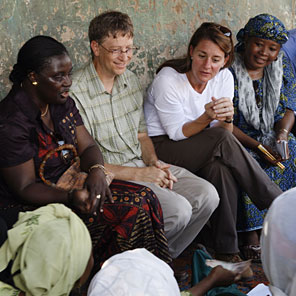财富与慈善:慈善资本主义的诞生 Wealth and 1)Philanthropy: The Birth of 2)Philanthrocapitalism
 The leading new philanthropists see themselves as social investors. The need for philanthropy to become more like the for-profit capital markets is a common theme among them, especially those who have made their fortune in finance. America’s early charitable foundations were built by entrepreneurs. 3)Carnegie and 4)Rockefeller would have understood the new investment-oriented model.
The leading new philanthropists see themselves as social investors. The need for philanthropy to become more like the for-profit capital markets is a common theme among them, especially those who have made their fortune in finance. America’s early charitable foundations were built by entrepreneurs. 3)Carnegie and 4)Rockefeller would have understood the new investment-oriented model.
“Having seen their own economic activity transform the world, they thought that the foundations they left behind would be transformative organizations,” says Carl Schramm, head of the 5)Ewing Marion Kauffman Foundation. Those foundations did remarkable things. Set up as 6)conduits for making grants as well as running the programmes that would benefit from the money, they thought big, concentrated on clear goals and were willing to invest heavily for long periods to achieve them, says Mr. Schramm. The Rockefeller Foundation, for example, found a cure for 7)yellow fever and drove the “8)green revolution” in agriculture. Carnegie, among other things, built thousands of public libraries.
Yet this long-term investment 9)ethos has proved to be the exception, not the rule. In a landmark article, Philanthropy’s New Agenda: Creating Value, Michael Porter and Mark Kramer described widespread flaws in America’s foundations that mostly remain to this day. For instance, little effort is devoted to measuring results, and foundations have unjustifiably high administration costs. 10)Arguably the biggest problem is the way that foundations make grants to organizations they support. Melissa Berman of Rockefeller Philanthropy Advisors argues that there is too much emphasis on funding individual programmes and too little on the sustainability of the non-profit organization running the programme.11)Overheads are seen as a bad thing, and grants tend to be short-term.
Should the new generation of philanthropists try something different from the traditional foundation? 12)EBay’s Mr. Omidyar thinks so. He has 13)folded his Omidyar Foundation into Omidyar Network, which is free to make for-profit investments as well as philanthropic donations to pursue its mission of “individual self-empowerment”. “After a few years trying to be a traditional philanthropist, I asked myself, if you are doing good, trying to make the world a better place, why limit yourself to non-profit?” he explains. Although there is a separate chequebook for the foundation, his “investment team” is free to put his money in either for-profit or non-profit projects. The team’s main 14)criterion is whether the investment will 15)further the social mission.
新一代主要的慈善家们将自己看作是社会投资者。他们之间有个共识,就是要把慈善事业变得更像是以盈利为目的的资本市场,在金融界起家的巨子、富商尤其赞同这一做法。美国早期的慈善基金会都由企业家创立。卡耐基和洛克菲勒也会明白这种新型、以投资为导向的模式。
“见到自己的经济活动改变了整个世界,他们认为自己所留下的基金会将是能带来变革的组织。”埃温·玛瑞恩·考夫曼基金会的主席卡尔·施拉姆说。那些基金会做出了非同寻常的事情。施拉姆说,作为筹集捐款以及运营捐款所资助项目的渠道,它们志向远大,专注于清晰的目标,并愿意长时间作巨额投资来实现这些目标。比如说,洛克菲勒基金会就发现了黄热病的疗法,并推动了农业的“绿色革命”。卡耐基基金会在其他方面有所建树——它建立了成千上万的公共图书馆。
然而,这种长线投资精神被证明只是一种例外的情况,而非常规。在一篇具有里程碑意义的文章《慈善事业的新议程:创造价值》中,迈克尔·波特和马克·克莱默阐明了美国存留至今的大多数基金会其普遍存在的问题。比如说,在衡量成果方面几乎未作努力,而且这些基金会的管理费用高得毫无道理。证据显示,最大的问题在于这些基金会向他们所支持的组织拨款的方式。洛克菲勒基金会慈善事业顾问梅丽 莎·伯曼指出,大家太看重对个别项目的资助,而过分轻视运营项目的非营利性组织的可持续发展。日常管理开支被看作是坏事,且拨款趋向于短期计划。
新一代的慈善家是否应该去尝试些不同于传统基金会的东西呢?eBay网的奥米迪亚先生就这么认为。他已经将其“奥米迪亚基金会”融入了“奥米迪亚网”,既能自由地以盈利为目的作投资,也能作慈善捐助,从而实现其“个人自强”的使命。“这么多年,我一直想要当个传统的慈善家,现在,我会问自己,如果是要做好事,想把这个世界变得更好,为什么要把自己限制在非盈利性组织的框框里呢?”他解释说。虽然有为其基金会单独准备的支票簿,他的“投资小组”依然能自由地将他的钱投资到盈利性或非盈利性项目上。这个小组对每项投资的评判标准是它是否能够推动实现其社会使命。
 The new philanthropists also need to be clear what they want to do, and stick with it. That is one lesson from the 16)Gates Foundation, which has already 17)notched up some remarkable achievements—helped by its huge size, which allows it to do things that are beyond everyone else. Its clear mission is to tackle global health inequalities in six main areas: infectious disease, HIV/AIDS,18)tuberculosis, reproductive health, global health strategies and global health technologies. Crucially, it has found ways of using its money to the greatest effect. Mr. Gates’s big idea is to overcome the market failure 19)afflicting poor consumers of health care by 20)deploying his money on behalf of the poor to generate the supply of drugs and treatments they need. For instance, the money provides market 21)incentives for drug companies to put some of their resources to work for the needy. The Gates Foundation also favors partnerships, even though it is big enough to pursue many projects on its own. Again, it is looking for maximum effectiveness. Other philanthropists are following similar strategies.
The new philanthropists also need to be clear what they want to do, and stick with it. That is one lesson from the 16)Gates Foundation, which has already 17)notched up some remarkable achievements—helped by its huge size, which allows it to do things that are beyond everyone else. Its clear mission is to tackle global health inequalities in six main areas: infectious disease, HIV/AIDS,18)tuberculosis, reproductive health, global health strategies and global health technologies. Crucially, it has found ways of using its money to the greatest effect. Mr. Gates’s big idea is to overcome the market failure 19)afflicting poor consumers of health care by 20)deploying his money on behalf of the poor to generate the supply of drugs and treatments they need. For instance, the money provides market 21)incentives for drug companies to put some of their resources to work for the needy. The Gates Foundation also favors partnerships, even though it is big enough to pursue many projects on its own. Again, it is looking for maximum effectiveness. Other philanthropists are following similar strategies.
Some foundations are now exploring new ways of funding organizations. Mr. Salamon of 22)Johns Hopkins University thinks that they should start to behave more like philanthropic banks, offering a range of financial products such as loans and loan guarantees as well as 23)grants. Some philanthropists are also beginning to think about how best to 24)harness all their assets to the causes they support, rather than just concentrating on the money they are currently giving away. This point was 25)brought home recently to 26)Jeff Skoll, one of whose philanthropic missions is to make films with a social message.
The biggest question of all is how to measure the performance of a philanthropic organization. A huge amount of work is going on in this field, but it is still more art than science—particularly when it comes to the 27)fuzzier goals of some philanthropists, such as “empowering people”, “increasing the effectiveness of civil society” or “fighting climate change.” Measures involving the so-called double bottom line (financial plus social performance) or triple bottom line (financial, social and environmental) are 28)readily 29)susceptible to statistical manipulation. One danger is to pay too much attention to managing inputs, which are easier to measure than output. Another is to concentrate donations on those activities that can be easily measured, such as the number of30)vaccinations given, even where that may not be the most effective way of tackling a problem.
Donors also need to 31)strike the right balance, so that on one hand they ask for enough information to be able to monitor the effectiveness of the organizations they fund but on the other they do not 32)bog them down in form-filling 33)bureaucracy. The Gates Foundation has a good reputation for getting the mix right and34)tailoring it to individual circumstances.
“The risk with any 35)metric is that people will come to see it as a description of reality, rather than a tool for a conversation about that reality,” says Rowena Young of the Skoll Foundation. “One metric or another can function well only when managers know why they are measuring and for whom...In the world of social value-creation, 36)context is king.”
新一代的慈善家还需要弄明白他们想要做什么,并坚持做下去。这是来自盖茨基金会的一个经验,这个基金会已经取得了一些引人注目的成就——由于其规模庞大,因而能做出其他基金会无法企及的事情。其目标很明确,就是要解决全球健康状况不平衡的问题,主要致力于六大领域:传染病、艾滋病、结核病、生殖健康、全球健康战略和全球健康科技。至关重要的是,它已经找到“将钱用在刀刃上”的方法。盖茨先生的宏伟愿景是有策略地利用他手中的钱替贫民刺激医疗产品和服务的供应,使其得到所需的药品和治疗,从而消除因市场失灵而给贫穷的医疗保健消费者带来的痛苦。比如说,把这些钱投入到医疗保健市场,刺激药品公司投放部分资源为贫民服务。盖茨基金会也主张建立合作关系,即便其规模已经大得足以独立运营许多项目。此外,该基金会正寻求方法使其效能最大化。其他慈善家也纷纷效法,采取类似策略。
有些基金会正在探寻新的方式向组织机构捐资。约翰·霍普金斯大学的萨拉蒙先生认为,他们行事应该开始更接近于慈善银行,提供一系列的金融产品,例如贷款、贷款担保以及补助等。有些慈善家也开始思考应该如何最佳地运用管理自己投入到各种慈善事业中的所有资产,而不是仅仅着眼于他们当前捐出的那笔钱。最近杰夫·斯科尔也意识到了这一点,他的慈善计划之一就是要拍摄传递社会信息的影片。
而最大的问题是,如何去衡量一个慈善组织的表现呢。在这方面有大量的工作正在进行,但大部分停留在主观评价,而非客观测量——特别是当某些慈善家的目标原本就相对含糊不清的时候,例如“激励人心”、“增强民权社会的效能”或“抗衡气候变化”等诸如此类。涉及到所谓的“双重底线”(金融及社会绩效)或“三重底线”(金融、社会和环境)的衡量标准都容易出现统计数字受人为影响而出现偏颇的情况。危险之一就是太过于关注管理的投入,因为投入比产出更容易衡量。另一个危险就是将捐助集中于那些容易衡量的活动中,例如提供接种疫苗的数量,即使那可能并不是解决某个问题的最有效途径。
捐助人也需要保持适当的平衡,所以,一方面他们要能让受捐组织提供足够的信息以监督其效能,另一方面又不能让这些组织陷入层层填表申请的官僚作风中。盖茨基金会在恰当保持两者平衡及因人而异方面口碑甚佳。
“任何一种衡量标准都具有这样一种风险——人们会将其看作是对事实的一种描述而不是一种用以谈论事实的准则,”来自斯科尔基金会的罗威娜·杨说,“只有当管理者明白他们衡量的原因以及对象时,某种衡量标准才能充分地发挥作用……谈到社会价值的创造,大环境才是王道。”






